Luxury Travel Review

Following renovation historic Paris hotel recycled tarpaulin into fashion accessories
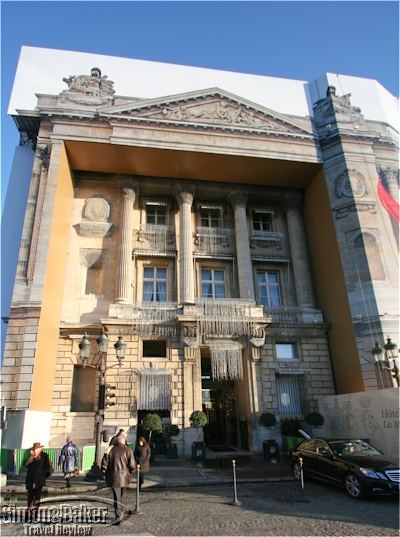
The tarpaulin above the entrance while the Hotel de Crillion was renovated
The last time one of our teams visited the Hotel de Crillon the icon property in the Golden Triangle of Paris, France was shielded by a large tarpaulin while renovations to the historic building took place. Following a year of meticulous renovations under the supervision of Etienne Poncelet, lead architect and head inspector of Historic Monuments, the luxury property designed originally by Ange-Jacques Gabriel emerged at the end of 2011.
Once the work was completed what was the hotel to do with the 1,300 square meters of tarpaulin that covered the scaffolding during the many months of renovations? Instead of tossing the material the Hotel de Crillon teamed up with Bilum to create Recycled Bags from the Hotel de Crillon, an exclusive line of 450 made in France bags and accessories that recently became available for purchase. The line includes three designs: Pouch for 25 euros, Clouch for 35 euros and Shopping Bag for 65 euros each (plus shipping for mail orders).
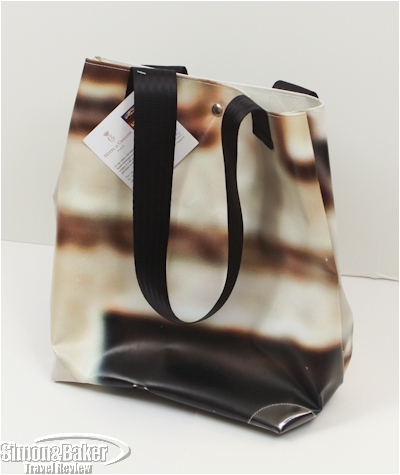
Our Shopping Bag, made in France with the discarded tarpaulin
Our Shopping Bag, 12 inches wide by 14 inches tall, has plastic reinforced corners at the bottom, two Crillon/Bilum tags, and a sales tag that identifies the bag as an original. The tag also says the bag was made in 2011 in a studio, “specialized in bagagerie and saddlery,” close to Paris.
The preparation work, carried out in Choisy-le-Roi, focused on the artistic and graphic aspects of sizing the tarpaulin into pieces fit for the line. The actual crafting of the bags and accessories took place at three specialized workshops in the Greater Paris region and the south of France. The project’s recycling, fashioning and finishing phases included the participation of a social integration and outreach program in the Greater Paris region.
The one-of-a-kind items, sold exclusively at the hotel gift shop (http://www.crillon.com/#atyourservice/theboutique, +33 44 71 1592, boutique@crillon.com), allow hotel guests and fans of the historic building to take home a piece of the Hotel de Crillon’s former tarpaulin facade while contributing 3 euros per item to the National Museum of Natural History association, which strives to preserve plant and animal biodiversity. Kudos to the hotel for its recycling efforts supported by local manufacturing and design.
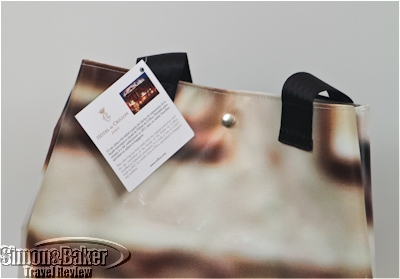
A tag explains the origin of the bag
Luxury yacht was ideal for Galapagos wilderness adventure
Article and photos by Josette King

The M/Y Grace at anchor in a secluded cove of the Galapagos archipelago
After a 1,000-kilometer flight over empty Pacific Ocean waters, the AeroGal Airlines jet was preparing to land on San Cristobal, the easternmost island of the Galapagos Archipelago. The few returning locals were already gathering their belongings. Meanwhile, we the tourists were craning our necks to catch a first glimpse of the islands. The plane banked, revealing under its wing a zigzag of rocky coastline, punctuated by an occasional crescent of white sand; and no discernible sign of human life. Another turn unveiled a dazzling panorama of ancient volcanic peaks and dark rock formations emerging from an impossibly blue sea. All this natural splendor, and we hadn’t yet landed.
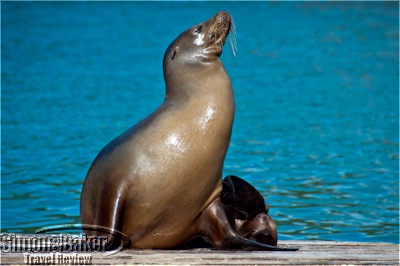
Galapagos sea lion
Once we did, I discovered another unique characteristic of the islands: the sense of undeniable entitlement of its wildlife. Even in the center of Puerto Baquerizo Moreno, the tiny provincial capital of the Galapagos adjacent to the airport, birds and reptiles and especially sea lions treated our presence with superb indifference. The later, enjoying their siesta sprawled on the boat dock, didn’t even twitch as I squeezed by to board the panga (local inflatable zodiac-type skiff) that was to take me to the Motor Yacht Grace.
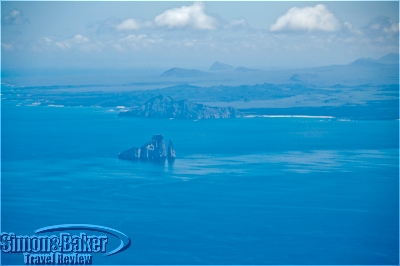
San Cristobal landing
My first glance at the elegant lines of this classic yacht was a special thrill. It brought back fantasies I had shared with an entire generation of French schoolgirls half a century before. Its owner was Prince Rainer III then, and it was named the Deo Juvante (Latin for with God’s help) after the motto of the house of Grimaldi, the rulers of the tiny French Riviera principality of Monaco for almost a millennium. For a few weeks in 1956, it had been front page news on French magazines and movies screens: the prince, sailing to meet the ocean liner USS Constitution to welcome his fiancee, the American movie star Grace Kelly; then the following week, Prince Rainer and the now Princess Grace boarding the yacht again for a seven-week honeymoon. Throughout the spring, there had been images of the yacht anchored in the most romantic destinations around the Mediterranean. Now this glamorous vessel was to be my home for a seven-night cruise around the Galapagos Archipelago, royal matrimony not required.
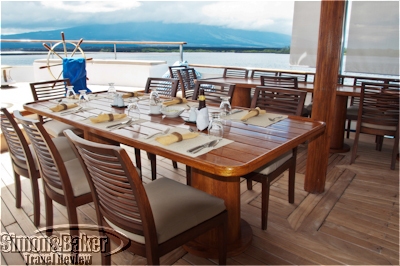
The shaded fresco dining area at the rear of the main deck
The yacht, renamed the M/Y Grace in homage to its most illustrious owner, is now the property of Quasar Galapagos Expeditions. Its owner Eduardo Diez, a man with a passion for classic yachts, oversaw a two-year, $2.5 million overhaul of the ship, while preserving its distinctive lines. The Grace, newly outfitted with a state-of-the-art stabilizer system to ensure smooth sailing on the open waters around the Galapagos islands, a large hot tub on the sundeck, modern bathrooms in each of its nine staterooms and air conditioning throughout, began operations in the spring of 2009. While I admit that it was the prospect of sailing on the Grace that propelled my desire to visit the Galapagos “some day” to the top of my travel wish list, the understated luxury of the vessel turned out to be merely the setting for a unique wilderness adventure. With only seven passengers and a crew of 10 on board, our naturalist guide, Rafael Pesantes Aguirre (Rafa for short) quipped that our odds for mutiny were unpromising.
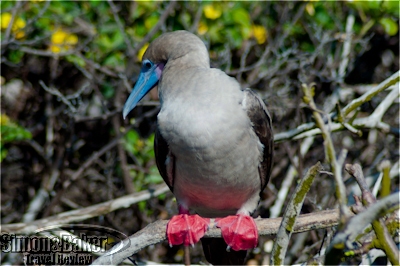
Red footed booby
But between the attentive pampering of the friendly staff and the exhilarating daily discoveries of the cruise, mutiny was the last thing on my mind. The exceptional itinerary took us to remote places rarely visited by larger ships. And Rafa, a third generation native of the islands and an ornithology graduate from San Francisco University in Quito, coupled an encyclopedic knowledge of the natural wonders of the area with the familiarity of one who has swum since childhood in the crystal clear waters of its most secluded coves. Our land excursions were filled with close encounters with some of rarest wildlife on the planet. We wandered on powdery white beaches shared only with colonies of sea lions and hiked along black lava rock paths to observe at close range the courtship ritual of Nazca boobies and waved albatross.
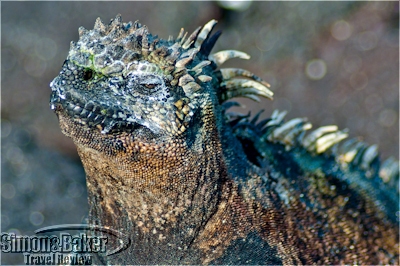
Fernandina marine iguana
We rode our panga along the edge of vertical cliffs dotted with blue-footed boobies and tiny Galapagos penguins, and watched frigate birds and brown pelicans nosedive for their breakfast. For me the highpoint of the day was invariably our snorkeling expedition. In island after island, Rafa led us to the most exotic marine life I have ever observed. I swan surrounded by so many giant sea turtles that it was a challenge to get out of their way. I observed a hammerhead shark, mercifully unconcerned by my presence; and I can now boast that I was personally pecked by a flightless cormorant! Visit the Simon & Baker Travel Review to read more about my Galapagos Archipelago cruise aboard the M/Y Grace.
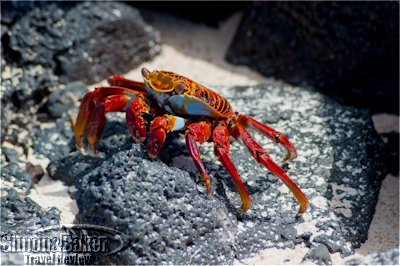
Sally Lightfoot crab
Residential area hotel a quiet luxury haven in busy Johannesburg
By Elena del Valle
Photos by Gary Cox
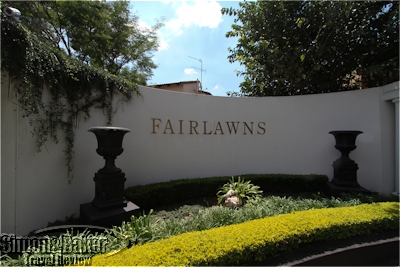
The entrance to Fairlawns
Tucked within a high end neighborhood in South Africa’s busy metropolis the Fairlawns Boutique Hotel & Spa offered a myriad amenities desirable to tired travelers like us. While we were familiar with several airport hotels which were more convenient the pretty grounds and luxury features of the Fairlawns appealed to us. As I sat on the grueling 15-hour flight from Atlanta, Georgia to Johannesburg, South Africa I dreamed of the comfortable bed, spacious bathroom with a shower and bathtub, quiet ambiance, and room service I would enjoy on arrival. We had stayed at the property previously and were confident it would serve our needs on this brief one night visit (see Pretty Johannesburg boutique hotel, spa in quiet residential neighborhood).
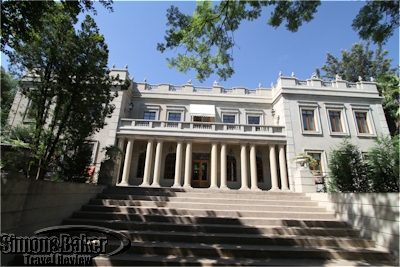
The Villa Suites building
We requested an airport pick up in advance to avoid the hassle of a car rental since we planned to be in the city less than one day. As we exited the busy arrivals hall at the airport I spotted our driver easily. We rode in air conditioned comfort into the city and less than an hour later we had settled into our accommodations for the night at the 40-room four acre hotel with 60 staff. Although the hotel restaurant and its new chef were a draw after so many hours of travel what I yearned for was a simple salad or sandwich while sitting comfortably in my bathrobe following a decadently hot shower or luxuriant bath.
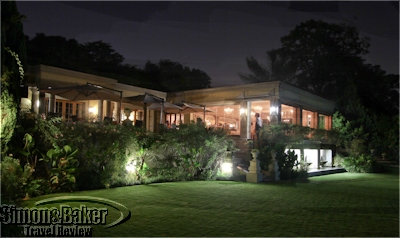
A view of the restaurant at night
The Toulouse Suite, Suite 39 in the Villa Suites building, delivered all that I had longed for on the flight and more. It was the first time we stayed at the Villas Suites, the newest of the buildings at the property, built behind and to the right of reception before the much anticipated 2010 World Cup.
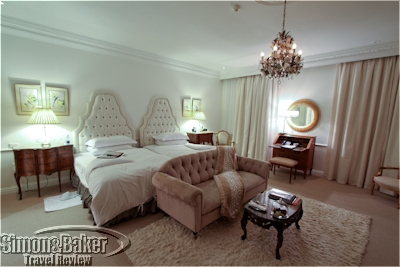
The Toulouse Suite
Our Deluxe Suite had the varied decorative touches and many luxury amenities we had liked in the past such as embroidered linen, stocked mini bar, and fruit plates. The 82 square meter room, one floor up from the ground floor via an elevator or a spiral staircase, was kept at a comfortable temperature with individually controlled air conditioning (and underfloor heating in the winter months).
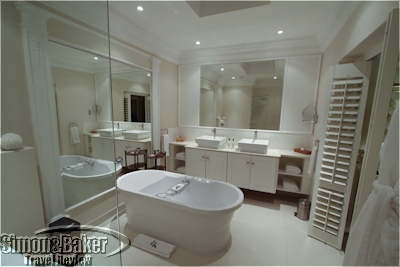
The bathroom was large with tub and shower
It was furnished with two double beds resting against off white fabric headboards and topped with a crisp white duvet with the Fairlawns logo. Although the room had an unremarkable view to a service walkway on the side of the building it was blissfully quiet, the most attractive feature for us the night we arrived. Double curtains covered the windows, providing privacy at night and shade from the fierce daytime sun. Antique style wood and marble top tables with matching glass bottomed lamps served as night tables. To one side there was an antique style wood desk with a beige stool where we set our computer and electronics during our stay.
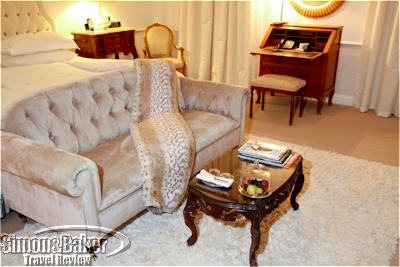
A comfortable seat and snacks
On the floor a putty colored carpet felt soft against our tired stockinged feet. Should we wish to make a call there were handheld wireless and regular phones. While we waited for room service to deliver our dinner order we sampled the fruit plate and a plate with mixed nuts and tasty biltong (South Africa dried beef) courtesy of the hotel. In the mini refrigerator there was complimentary cold still mineral water, juice and two dried mango snacks.
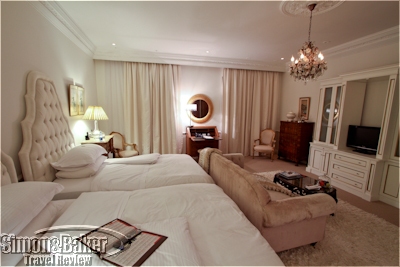
A view of the room from the corner next to the bathroom
In front of the bed, on the right side of the single ambiance room, there was a putty colored sofa atop a white rug facing a glass topped wood coffee table. Across from the table was an entertainment section with a Hi Sense flat screen television in the center and the mini bar to the lower right. Antique framed silk birds and landscapes adorned the walls and in the center, an elaborate chandelier with a porcelain flower motif hung from the ceiling. There was a stand alone wood armoire where we hung some of our clothes after the bell hop set our suitcases on the large luggage rack near the entrance.
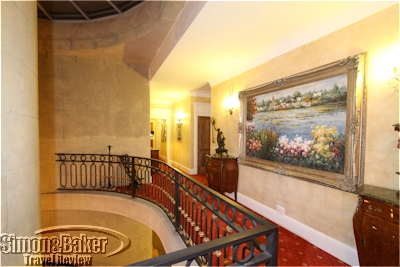
The Villa featured pretty common areas
The next morning we awoke refreshed and ready to face the day. There was complimentary coffee and tea service on the first floor across from our suite. After checking emails with the complimentary WiFi services I headed to the spa for a work out (there was a spacious fitness section with treadmills, exercise machines and free weights within the spa building, I remembered from past visits). Next we enjoyed the lovely breakfast buffet and hot made to order options. On the long table, covered with a cloth to keep the flies off, there were fresh fruit plates, breads and pastries, jams, yogurt, cheese, salmon, and deli meats. The staff were friendly and attentive.
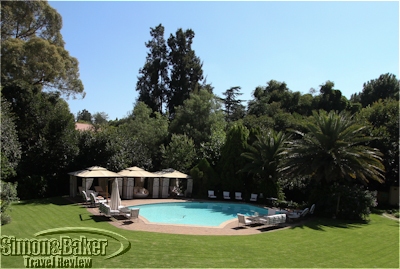
The pool area at Fairlawns
From our window side table we had an expansive view of the central lawn and pool area. I felt like I could have stayed there the whole morning. Instead I donned by bathing suit and lounged poolside for the better part of an hour. I even managed a swim in the chilly water. While chatting with a fellow guest one of the staff from breakfast walked down to check on us, politely offering beverages and snacks. We had both had our fill at breakfast and declined.
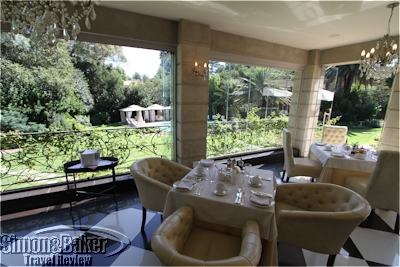
The dining room at breakfast looking out over the property
While I was at the pool a kind staff person ironed my linen clothes and by the time we left I looked rested and presentable, a concept that was hard to imagine while I was breathing stale air on the airplane less than 24 hours earlier. That rested state is one of the reasons the Fairlawns Boutique Hotel and Spa (91 Alma Road, off Bowling Avenue, Morningside, Gallo Manor, Sandton 2052, Johannesburg, South Africa, +27 11 804 2540/1/2/3, +27 11 808 7300 or +27 73 481 7734, http://www.fairlawns.co.za/, fairlawn@fairlawns.co.za) remains on our list of favorite boutique hotels in Johannesburg.
Our short tour of Saba including a glass shop visit
By Elena del Valle
Photos by Gary Cox
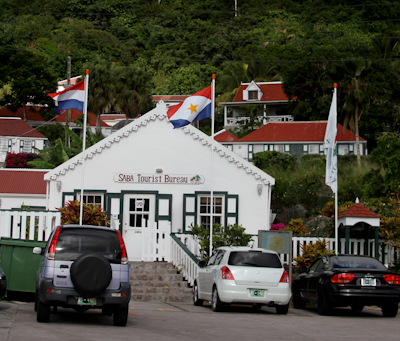
The Saba Tourist Bureau
I loved Saba, a small Dutch Caribbean island, for its unspoiled and picturesque character. What this volcanic Leeward Island lacked in size it made up for in beauty, natural features and sheer determination. For example, the islanders were told by experts in Holland early last century that it was not possible to build a road due to the steep incline of the mountains. Refusing to accept that ruling one man took a correspondence course and with the help of his fellow islanders built the beginning of what today is called simply The Road.
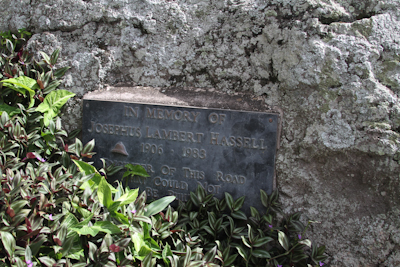
A plaque to Josephus Lambert Hassell, engineer of the road
With a population of less than 1,500 and diminutive (it occupies five square miles), the tourist attractions were mainly scenic, we expected before visiting the island. Cars were scarce in Saba. We had a few hours to see what we could while our ship, the SeaDream I, stopped there and we intended to make the most of it. With a little help from the crew we were able to find a taxi, the only one available that day apparently. The driver, a friendly Irishman who had relocated to Saba only a few months earlier with his van (the windows in the rear of the van did not open we later discovered with disappointment), explained that he would be pleased to show us around the island if we were willing to share space and wait for him.

Saba in the foreground and remote islands on the horizon
Six of us shared the van up the narrow and steep roads. He dropped two of our group at the entrance to a hiking trail (they reported having a wonderful time later when we met up aboard the ship) before leaving us in The Bottom, the island’s main urban area. He would take care of local customers (many of the medical school students were going on vacation and there was a wedding the next day) who had booked his services already and return for us about 90 minutes later.
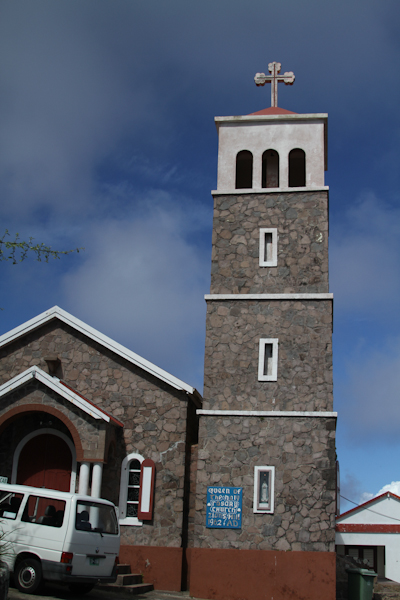
We stopped at this church with a view
When he returned he had a glass of fresh made fruit juice with us before the four of us climbed into his van to see the sights. Minutes later we felt transported back in time when we stopped at a small church with a million dollar view. Although the church was closed there was a kind lady running a simple small cash only shop behind the church. She sold handmade lace in the tradition and style of Saba, a dying art, our driver shared as we departed having bought one of the treasured lace pieces.
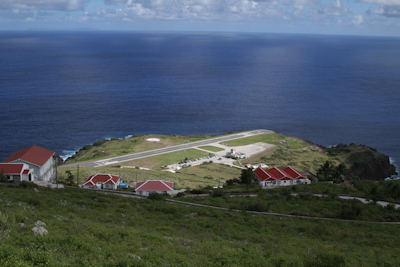
The tiny Saba airport
From there we drove downhill toward the waterfront island airport. On our way back our driver showed us the house he rented as we drove by it on way back toward The Bottom and the dock where we had arrived.
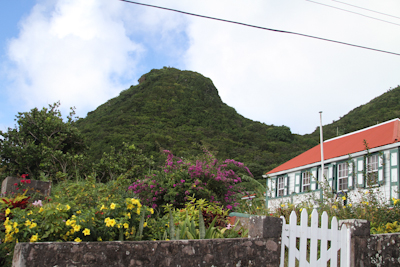
Cute little houses and flowers dotted the hills
Earlier while we waited for our guide and driver to return we had made our way around the hilly village, picking up tips and information at the tourist office where a friendly staff person welcomed us, passing a cafe and small indoor market and walking up a steep hill toward JoBean Glass unsure if it was open for business. Our efforts were rewarded when we arrived at the un-airconditioned shop and found it open. A shy young lady inside said we were welcome to browse around at our leisure. Every surface, every corner of the shop was filled with glass items, many made from Venetian glass, we later found out from the friendly owner who popped by for a few minutes.
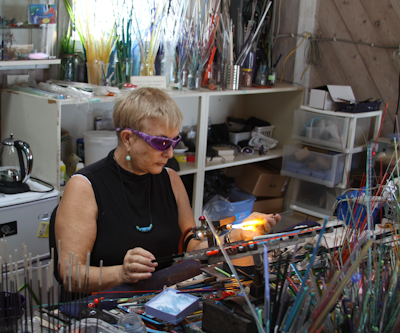
JoBean Chambers demonstrating a technique to fashion colorful glass jewelry
JoBean Chambers, a lively and vivacious American woman who had lived and worked on the island for many years, showed us the glass pieces she was making for the wedding we had heard about, and gave us a brief glass making demonstration. Watching her flame work the thin and colorful glass tubes it seemed easy to create pretty seahorses, turtles, frogs, fish, mermaids, dive flags, starfish and other attractive shapes. She would heat and swirl the glass quickly and easily (for her), then attach another piece of glass in a different color to the incipient shape, adjusting the width and style along the way. In moments we could distinguish a multicolored frog and after that a mermaid. It was hard to imagine the glass melts at temperatures of more than 2,000 degrees Fahrenheit.
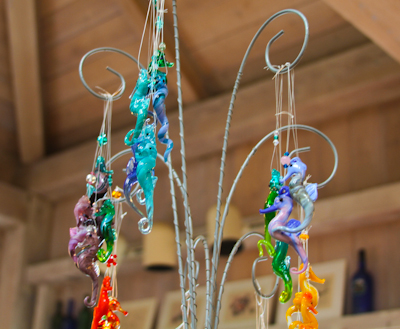
Many of her glass creations were sea creatures
A fan of hot glass since 1989 she had learned her skills, in part at El Vetro in Venice, Italy where she studied, according to her website, with Lucio Bubacco and Vittorio Constantini. Her work was exhibited in art galleries in the United States and the Caribbean, including the Corning Museum Shop. She offered glass workshops in her hillside studio for up to five students at a time. Next time we visit Saba maybe we will take one of her workshops.
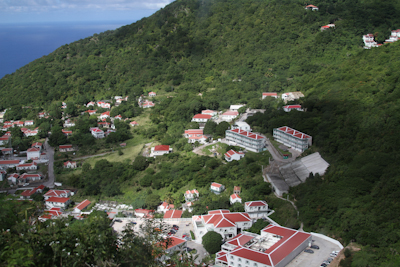
Our visit to Saba was a special treat and one of my fondest memories from our week long Caribbean cruise. This was in part because of the pretty hillside houses in the small towns, the old style lace sold behind the church, our shared taxi tour and fun stop at JoBean Glass Art Studio (Booby Hill, Windwardside Saba, Dutch West Indies,+ 599 416 2490,www.jobeanglassart.com, jobean@jobeanglassart.com).
Eataly, paradise for this food lover
Article and photos by Margot Liebman

The entrance to Eataly from 23 street
Eataly was the perfect combination of old-world European market and true Manhattan glamour. Centrally located on 23 Street, one of the main cross-town routes in New York City, it was easy to get to and fun to visit. I went with friends on a Saturday afternoon in October, a popular time to go, and again in March. It seemed to me that locals and tourists were visiting Eataly.

An example of the signage scattered throughout Eataly
When I walked in I noticed two things, an exquisite selection of produce and a huge crowd. I admit that I panicked, but only momentarily. After marveling at the orange chanterelle mushrooms, baby purple artichokes, and tiny rock-like potatoes, I made my way into the main part of the market.
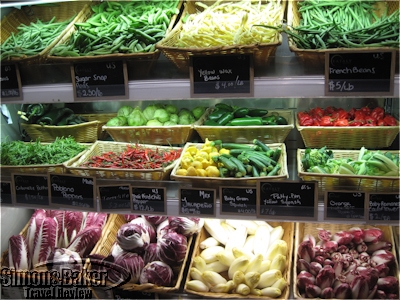
The produce display near Eataly’s main entrance
The entire place was over 50,000 square feet (4,600 square meters) with high ceilings and pools of light. There were marble tables, white walls, stainless steel shelves and an abundance of food. The market sections had packaged pastas, sauces, olives, meats, sweets and many imported items. There was a Gelateria (Italian ice cream section), an espresso bar, a chocolate counter, a fishmonger, a butcher, and a bookshop. It was a bit overwhelming, but after I took some time to wander around I got the lay of the land.
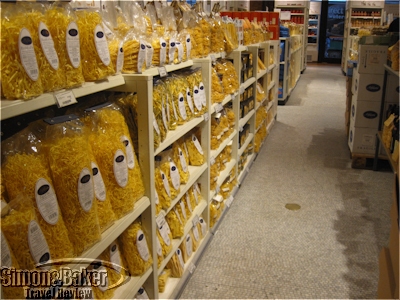
One of the pasta aisles in the market
There were six restaurants, each one focusing on one type of food. Il Manza (reservations were required for this one), Il Pesce (Italian for the fish), Le Verdure (Italian for vegetables), Birreria (Italian for the beer place), La Piazza (The Plaza, selling sandwiches and charcuterie products) and La Pizza & La Pasta. We found a spot at the bar at Il Pesce where we had a direct view into the kitchen.
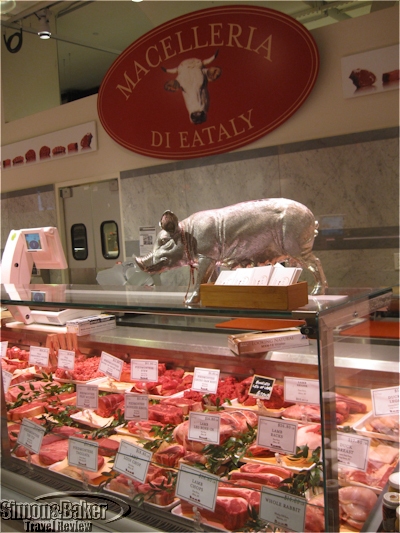
Macelleria, where you can buy fresh red meat
To start we ordered a raw fish selection that included sea bass and tuna topped with tiny roe and a citrus glaze. It was better than my favorite sushi restaurant. Next was a whole branzino (a silver-skinned fish found in European sea and saltwater lakes) prepared simply on a salty bed of paper-thin potatoes. We also ordered grilled scallops in a lemon and butter sauce served in a large seashell. On the side we had a bed of sautéed, garlicky mustard greens. The fish was fresh and flavorful, and each dish complemented the other. The service was fast and friendly and we had a great time watching the chefs prepare each plate.
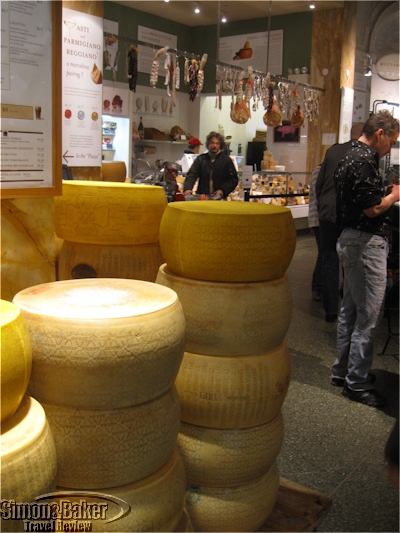
Rounds of cheese stored near the wine bar
Next, we toured the market. On some days Eataly offered classes. I planned to check the website’s Learn section for a schedule of upcoming programs. In the past, topics have ranged from olive oil tastings to cooking classes, to history of Italian Cuisine with prices between $60 and $275.
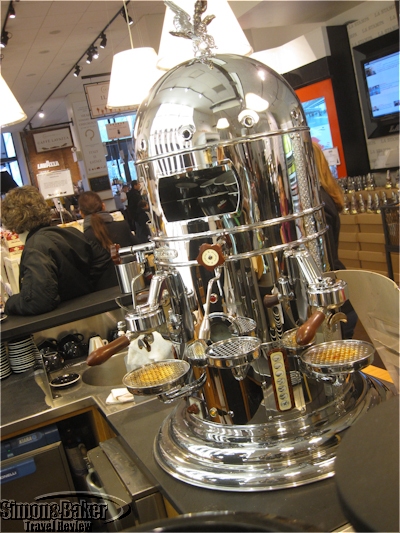
The antique-style espresso machine made a delicious cappuccino!
That day there was a free grappa tasting so we tasted a few sweet liquors like Strega and Limoncello. Next we made our way to the espresso bar where coffee was served from an antique-style machine. Of course, we also had to try the Gelateria and helped ourselves to a raspberry and chocolate double-scoop; when I closed my eyes I thought we were eating a real raspberry.
Overall, Eataly appeared to me to be a food-lover’s paradise. Offerings the day I was there were high quality, exotic, fun and well organized. Staff served the food quickly. We paid the kind of high prices we have paid at upscale Manhattan food shops.
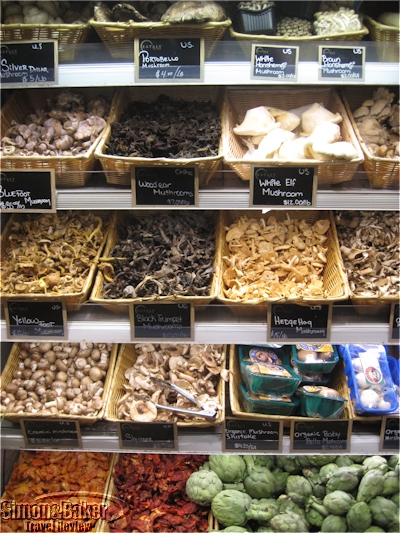
Mushrooms, artichokes and dried peppers in the produce section
Eataly was founded and created by Oscar Farinetti, an Italian entrepreneur. His partners included Mario Batali and Lidia Bastianich, celebrity chef and restaurateur respectively, as well as Joe Bastianich, a restaurateur and Lidia’s son. I liked that Eataly partnered with Slow Food, a nonprofit organization founded to counteract fast food and fast life.
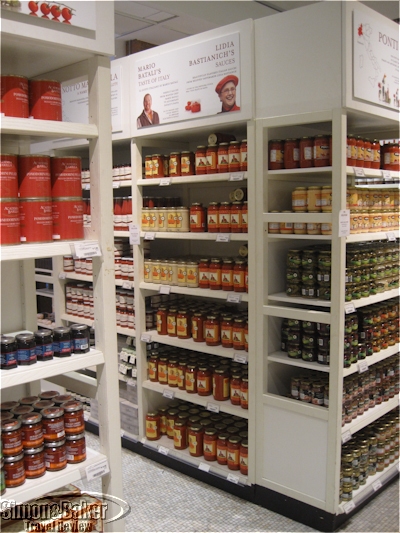
The store offers many imported goods such as these pasta sauces
I will return because I had so much fun exploring the whole place and I would like to try the other restaurants. If I were in the neighborhood, I might stop in just for a scoop of gelato at Eataly NYC (200 5th Avenue, New York City, (212)229-3560, info@eataly.com, www.eatalyny.com).
Outstanding Ecuadorean Amazon lodge preserved ancestral territory, traditions
Article and photos by Josette King
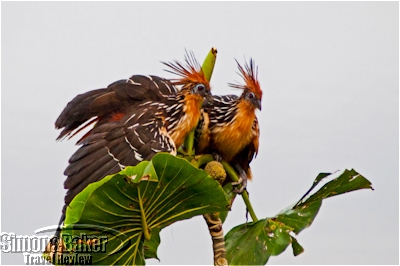
Hoatzin birds were a frequent sight near the lodge
“Stop, stop!” I sputter, too excited to keep my voice down. Fabian, the local park ranger who is paddling, doesn’t speak English but he gets the idea and brings the canoe to a smooth halt. Roberto, my Ecuadorian guide who speaks English fluently, looks at me askance. He has just pointed out a large bird perched in the dense jumble of rainforest. It looks like a chicken with too much turquoise eye shadow and a bad hair day. “The bird,” I exclaim. “Yes, it’s a hoatzin,” he reiterates matter-of-factly. He clearly fails to grasp the importance of the moment. So does the bird, which has by now been joined by two of its friends. They are engaged in a croaky argument while heartily tucking into the foliage. I feel compelled to explain that on a previous Amazon visit, a thousand miles downriver from here, I had once spent a whole week, including a half-day hike in the waterlogged underbrush, in search of a hoatzin. And I had only managed to hear its distinctive cry and ponderous take off as it vanished into the forest canopy. “We have lots of hoatzins here,” Roberto assures me after I have photographed these to my heart’s content, and for good measure a rare rufescent-tiger heron that has been observing the proceedings from a nearby stump.
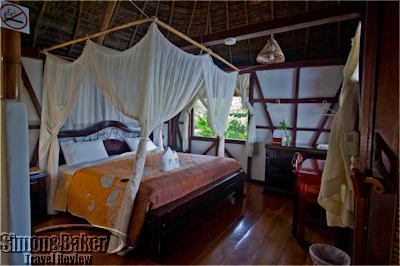
The king size bed was draped in mosquito netting
We resume our slow way upstream under an arch of tangled mangroves and palms, along the narrow channel that connects the Napo River, one of the most important tributaries of the Amazon, to Anangucocha Lake. We are in the heart of 21,400 hectares (82 square miles) of conservation land located on the ancestral territory of the Kichwa Anangu community, in the northwest corner of Ecuador’s Yasuni National Park. The park is a UNESCO Biosphere Reserve regarded by scientists as one of the most bio-diverse areas on the planet. Several notable sightings later, including a tree-toed sloth and my first ever monk saki monkey, we reach the lake. On its far side, the shore is dotted with the thatched-roofed, bright ocher adobe bungalows of the Napo Wildlife Center luxury eco-lodge.
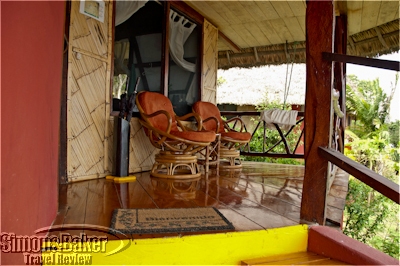
My bungalow had a shaded terrace overlooking the lake
Set into some of the most pristine rainforest environment I have ever visited, the lodge is designed to meet the high expectations of international tourists for wilderness accommodations. It features attractive bungalows with private terraces overlooking the lake, modern bathrooms, round the clock electricity and WiFi connection throughout the property. Strategically located observation towers at the lodge and in the forest offer a unique perspective of the abundant wildlife around the lake and above the forest canopy. My wildlife viewing is exceptional, not only for its abundance and variety but because of the excellence of the guiding. At the lodge, guides come in pairs: a bilingual, state-licensed guide and a native Yasuni Park-licensed ranger who also acts as a local guide, sharing his knowledge of plants, medicinal plants and Kichwa traditions. One evening, they take me on a nighttime canoe ride in the swamps near the lodge, with a special spotlight to view nocturnal creatures.
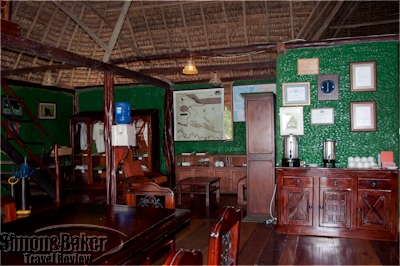
Coffee was served around the clock in the main hall
Beyond the excellence of accommodations and wildlife viewing opportunities, a highpoint of my visit is the opportunity to observe first hand the positive impact of the Napo Wildlife Center on the daily life of the Anangu people. The lodge and conservation land are wholly owned and managed by the Kichwa Anangu community. They are the keystones of a far-reaching program to improve the quality of life of the people and preserve the integrity of their ancestral territory and culture while providing them with sustainable employment. Most of the staff comes from the community. Their pride in the Napo Wildlife Center is palpable, and translates into warm and attentive service. Additionally, while the life of the community is separated from tourism activities, one hour downstream from the lodge, I see women welcome guests to the Interpretation Center facility adjacent to their village. It is especially rewarding to be able to connect with them (with Roberto as interpreter) as they introduce me to the tasks of their daily lives as well as their traditional Kichwa crafts and dances.
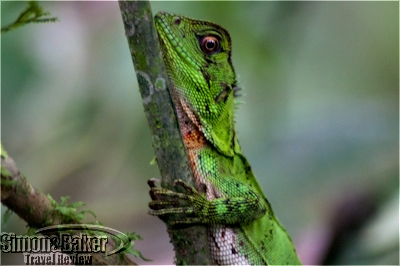
An Amazon forest dragon
I am gratified to hear of the rigorous sustainable tourism practices implemented by the Napo Wildlife Center program. Profits are reinvested within the community, with education and healthcare as major priorities. The center also returns a share of the annual profits to each family and provides a stipend to the elderly. To limit the lodge’s impact on its environment, it has implemented an environmentally sustainable sewage system, with waste waters treated to high standards before being released into the swamps. Trash is kept to a minimum and composted whenever possible. What is safe to burn is burned and buried, with the remainder transported to designated landfills outside the park. And these practices have been extended to the Anangu community at large, for a cleaner, healthier living environment.
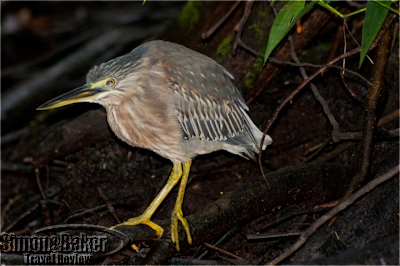
A striated heron
The Napo Wildlife Center is also engaged in a strong anti-poaching program, with its conservation land patrolled by community rangers employed and equipped by the lodge. The Napo Wildlife Center was recognized in 2009 with the Rainforest Alliance Community Sustainable Trend Setter Award, and the Best Jungle Lodge Award from the Latin American Travel Association at the World Travel Market in London, U.K. And it is becoming a model for other sustainable tourism community projects throughout Ecuador.
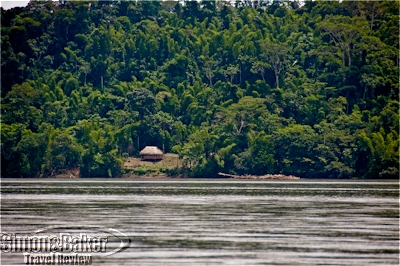
The banks of the Napo River were a tangle of dense rainforest
And by the way, Roberto was right. We came across so many hoatzins during my four-day visit that by the time I left, I barely spared them a glance. Visit the Simon & Baker Travel Review to read more about my stay at the Napo Wildlife Center.








